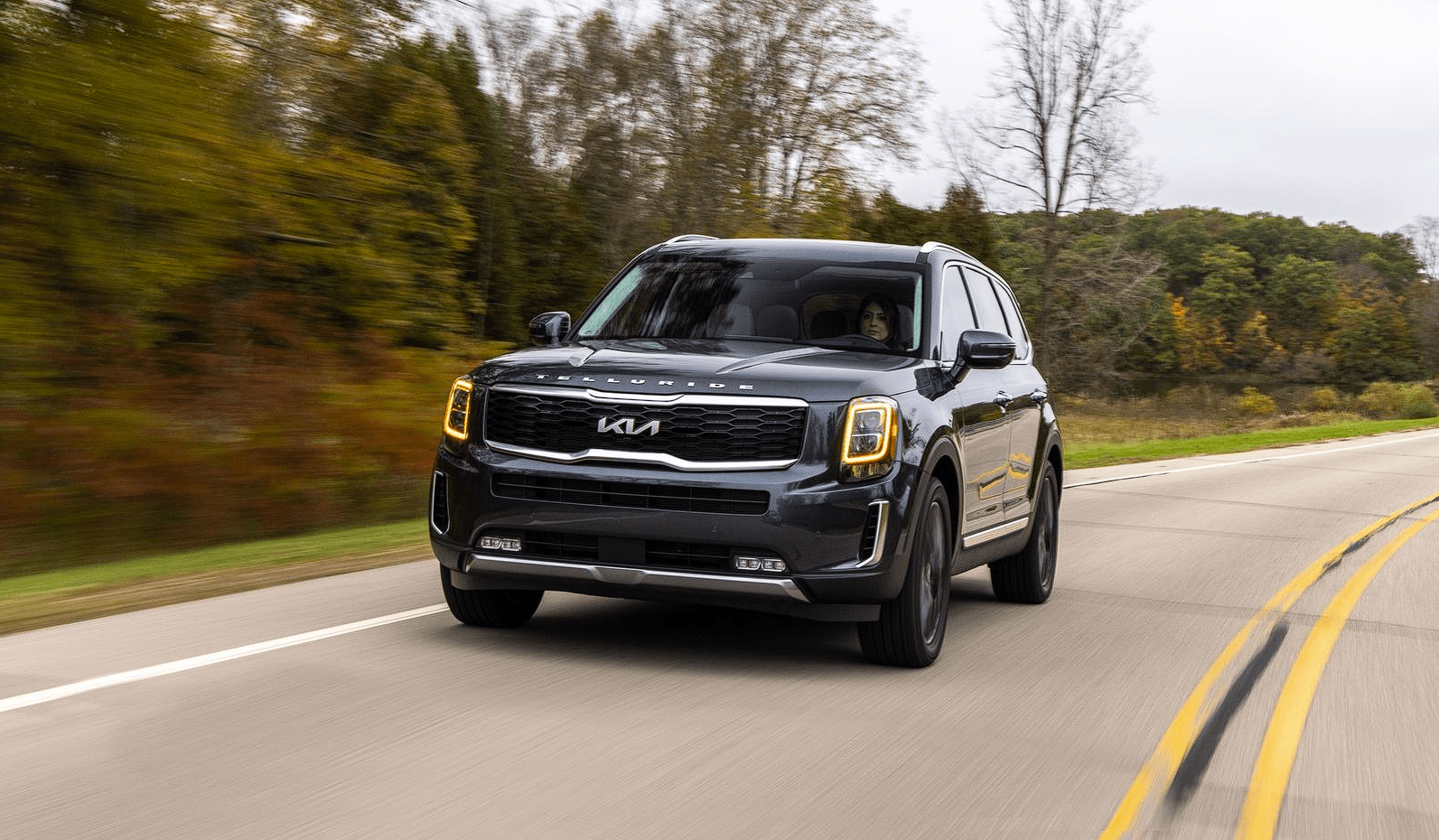2022 Kia Telluride Forward Collision-Avoidance Assist and Lane-Keeping Assist
The 2022 Kia Telluride has a lot of high-tech safety features, like the Forward Collision-Avoidance Assist (FCA) and Lane Keeping Assist (LKA) systems, which work together to make the car safer for passengers and easier to drive. Sensors and cameras in the Forward Collision-Avoidance Assist system watch the road ahead for possible accidents with other cars or people walking. When a danger is detected, it can let the driver know and, if necessary, apply the brakes automatically to lessen the impact or completely avoid a crash. To go along with this, the Lane Keeping Assist system uses the same kind of sensors to keep an eye on where the car is in the lane and help the driver keep it straight. By gently steering the car back into its lane when it drifts out of its lane, these systems not only improve safety but also make driving more confident and relaxed. They show how the 2022 Kia Telluride is committed to protecting its passengers and other drivers on the road.
2023 Kia Telluride Specs, Price, Features and Mileage (Brochure)
Forward Collision-Avoidance Assist (FCA) (Sensor fusion)
Forward Collision-Avoidance Assist is designed to help detect and monitor the vehicle ahead or help detect a pedestrian or cyclist in the roadway and warn the driver that a collision is imminent with a warning message and an audible warning, and if necessary, apply emergency braking.
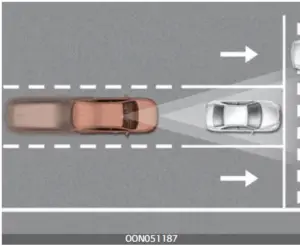
NOTICE
FCA stands for Forward Collision-Avoidance Assist.
Detecting sensor

[1]: Front view camera, [2]: Front radar
Refer to the picture above for the detailed location of the detecting sensors.
CAUTION
Take the following precautions to maintain optimal performance of the detecting sensor:
- Never disassemble the detecting sensor or sensor assembly, or apply any impact on it.
- If the detecting sensors have been replaced or repaired, have your vehicle inspected by an authorized Kia dealer.
- Never install any accessories or stickers on the front windshield, or tint the front windscreen.
- Pay extreme caution to keep the front view camera dry.
- Never place any reflective objects (i.e. white paper, mirror) over the dashboard. Any light reflection may prevent the function from functioning properly.
- Do not apply license plate frame or objects, such as a bumper sticker, film or a bumper guard, near the front radar cover.
- Always keep the front radar and cover clean and free of dirt and debris. Use only a soft cloth to wash the vehicle. Do not spray pressurized water directly on the sensor or sensor cover.
- If unnecessary force has been applied to the radar or around the radar, Forward Collision-Avoidance Assist may not properly operate even though a warning message does not appear on the cluster. In this case, have your vehicle inspected by an authorized Kia dealer.
- Use only genuine parts to repair or replace a damaged front radar cover. Do not apply paint to the front radar cover.
Forward Collision-Avoidance Assist Settings
Setting features Forward Safety

With the ENGINE START/STOP button in the ON position, press the MODE button ( ) several times on the
steering wheel until User Settings menu appears on the LCD display. Select Driver Assistance → Forward Safety from the setting menu to set whether or not to use each function.
- If Active Assist is selected, the function will warn the driver with a warning message, an audible warning and steering wheel vibration depending on the collision risk levels. Braking assist will be applied depending on the collision risk.
- If Warning Only is selected, the function will warn the driver with a warning message, an audible warning depending on the collision risk levels. Braking will not be assisted. The driver must apply the brake pedal or steer the vehicle if necessary.
- If Off is selected, the function will off. The warning light will illuminate on the cluster.
The driver can monitor Forward Collision-Avoidance Assist ON/OFF status from the settings menu. If the warning light remains ON when the function is ON, have the function checked by an authorized Kia dealer.
WARNING
- When the engine is restarted, Forward Collision-Avoidance Assist will always turn on.
- If ‘Off’ is selected from the settings menu, the Forward Collision Assist will not operate so the driver should always be aware of the surroundings and drive safely.
CAUTION
If ‘Warning Only’ is selected, braking is not assisted.
NOTICE
Forward Collision-Avoidance Assist will turn off when ESC is turned off by pressing and holding the ESC OFF button and the will illuminate.
warning light
Warning Timing
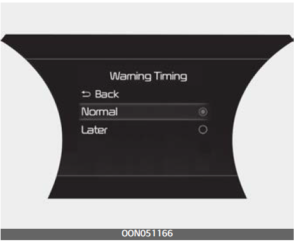
With the ENGINE START/STOP button in the ON position, press the MODE button ( ) several times on the
steering wheel until User Settings menu appears on the LCD display. Select Driver Assistance → Warning Timing to change the initial warning activation time for Forward Collision-Avoidance Assist.
When the vehicle is first delivered, Warning Timing is set to Normal. If you change the Warning Timing, the warning time of other Driver Assistance systems may change.
Warning Volume

With the ENGINE START/STOP button in the ON position, press the MODE button ( ) several times on the
steering wheel until User Setting menu appears on the LCD display. Select Driver Assistance → Warning Volume to change the warning volume to High, Medium, Low or Off for Forward Collision-Avoidance Assist.
If you change the Warning volume, the Warning volume of other Driver Assistance functions may change.
CAUTION
- The setting of the Warning timing and Warning volume applies to all functions of Forward Collision-Avoidance Assist.
- Even though Normal is selected for Warning timing, if the front vehicle suddenly stops, the initial warning activation time may not seem late.
- Select Late for Warning Timing when traffic is light and when driving speed is slow.
NOTICE
If the engine is restarted, Warning timing and Warning volume will maintain the last setting.
Forward Collision-Avoidance Assist Operation.
Warning and Control
The basic function for Forward Collision-Avoidance Assist is to warn and control the vehicle depending on the collision level: Collision Warning and emergency Braking.
Collision Warning

- To warn the driver of a collision, the Collision Warning warning message will appear on the cluster, an audible warning will sound and the steering wheel will vibrate.
If a vehicle is detected in front, the function will operate when your vehicle speed is between approximately 6~93 mph (10~150 km/h). - If a pedestrian or cyclist is detected in front, the function will operate when your vehicle speed is between approximately 6~53 mph (10~85 km/h).
Emergency Braking
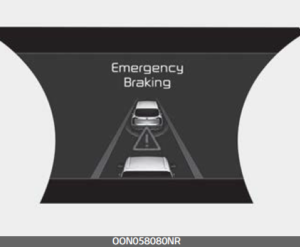
- To warn the driver that emergency braking will be assisted, the ‘Emergency Braking’ warning message will appear on the cluster, an audible warning will sound and the steering wheel will vibrate.
- If a vehicle is detected in front, the function will operate when your vehicle speed is between approximately 6~45 mph (10~75 km/h).
- If a pedestrian or cyclist is detected in front, the function will operate when your vehicle speed is between approximately 6~40 mph (10~65 km/h).
- In emergency braking situations, braking is assisted with strong braking power by the function to help prevent collision with the vehicle, pedestrian or cyclist ahead.
WARNING
- For your safety, change the settings after parking the vehicle at a safe location.
With Active Assistor Warning Only selected, when ESC is turned off by pressing and holding the ESC OFF button, Forward Collision-Avoidance Assist will turn off automatically. In this case, the function cannot be set from the settings menu and the warning light will illuminate on the cluster which is normal. If ESC is turned on by pressing the ESC OFF but-ton, Forward Collision-Avoidance Assist will maintain the last setting. - Forward Collision-Avoidance Assist does not operate in all situations or cannot avoid all collisions.
- The driver should hold the responsibility to control the vehicle. Do not solely depend on Forward Collision-Avoidance Assist. Rather, maintain a safe braking distance, and if necessary, depress the brake pedal to reduce driving speed or to stop the vehicle.
- Never deliberately operate Forward Collision-Avoidance Assist on people, animals, objects, etc. It may cause serious injury or death.
- Forward Collision-Avoidance Assist may not operate if the driver depresses the brake pedal to avoid collision.
- Depending on the road and driving conditions, Forward Collision-Avoidance Assist may warn the driver late or may not warn the driver.
- During Forward Collision-Avoidance Assist operation, the vehicle may stop suddenly injuring passengers and shifting loose objects. Always have the seat belt on and keep loose objects secured.
- If any other functions warning message is displayed or an audible warning is generated, the Forward Collision-Avoidance Assist warning message may not be displayed and an audible warning may not be generated.
- You may not hear the warning sound of Forward Collision-Avoidance Assist if the surrounding is noisy.
- Forward Collision-Avoidance Assist may turn off or may not operate properly or may operate unnecessarily depending on the road conditions and the surroundings.
WARNING
- Even if there is a problem with Forward Collision-Avoidance Assist, the vehicle’s basic braking performance will operate normally.
- During emergency braking, braking control by the function will automatically cancel when the driver excessively depresses the accelerator pedal or sharply steers the vehicle.
CAUTION
- Depending on the condition of the vehicle, pedestrian and cyclist in front and the surroundings, the speed range to operate Forward Collision-Avoidance Assist may be reduced. The function may only warn the driver, or the function may not operate.
- It operates only under certain conditions by judging the danger according to the condition of the oncoming vehicle, driving direction, speed and the surrounding environment.
Forward Collision-Avoidance Assist Malfunction and Limitations
Forward Collision-Avoidance Assist malfunction

When Forward Collision-Avoidance Assist is not working properly, the Check Forward Collision-Avoidance Assist system warning message will appear (turns off after a certain When Forward Collision-Avoidance Assist is not working properly, the Check Forward Collision-Avoidance Assist system warning message will appear (turns off after a certain time), and the and warning lights will illuminate on the cluster. In this case, have the vehicle inspected by an authorized Kia dealer.
Forward Collision-Avoidance Assist disabled
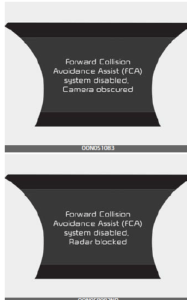
When the front windscreen where the front view camera is located, front radar cover or sensor is covered with foreign material such as snow or rain, it can reduce the detecting performance and temporarily limit or disable Forward Collision-Avoidance Assist. If this occurs the Forward Collision-Avoidance Assist (FCA) system is disabled. Radar blocked warning message will appear (turns off after a certain time), and the and warning lights will illuminate on the cluster.
The function will operate normally when snow, rain or foreign matter is removed. If the function does not operate normally after it is removed, have the vehicle inspected by an authorized Kia dealer.
2023 Kia Telluride Specs, Price, Features and Mileage (Brochure)
WARNING
- Even though the warning message or warning light does not appear on the cluster, Forward Collision-Avoidance Assist may not properly operate.
- Forward Collision-Avoidance Assist may not properly operate in an area (e.g. open terrain), where any substance are not detected after turning ON the engine.
Limitations of Forward Collision-Avoidance Assist
Forward Collision-Avoidance Assist may not operate normally, or the function may operate unexpectedly under the following circumstances:
- The detecting sensor or the surroundings are contaminated or damaged
- The temperature around the front view camera is high or low due to the external environment
- The camera lens is contaminated due to tinted, filmed or coated windscreen, damaged glass, or stuck of foreign matters (sticker, bug, etc.) on the glass
- Moisture is not removed or frozen on the windscreen
- Washer fluid is continuously sprayed, or the wiper is on
- Driving in heavy rain or snow, or thick fog
- The field of view of the front view camera is obstructed by sun glare
- Street light or light from an oncoming vehicle is reflected on the wet road surface, such as a puddle on the road
- An object is placed on the dashboard
- Your vehicle is being towed
- The surrounding is very bright
- The surrounding is very dark, such as in a tunnel, etc.
- The brightness changes suddenly, for example when entering or exiting a tunnel
- The brightness outside is low, and the headlamps are not on or are not bright
- Driving through steam, smoke or shadow Only part of the vehicle, pedestrian or cyclist is detected
- The vehicle in front is a bus, heavy truck, truck with unusually shaped luggage, trailer, etc.
- The vehicle in front has no tail lights, tail lights are located unusually, etc.
- The brightness outside is low, and the tail lamps are not on or are not bright
- The rear of the front vehicle is small or the vehicle does not look normal, such as when the vehicle is tilted, overturned, or the side of the vehicle is visible, etc.
- The front vehicle ground clearance is low or high
- A vehicle, pedestrian or cyclist suddenly cuts in front
- The bumper around the front radar is impacted or damaged or the front radar is out of position
- The temperature around the front radar is high or low Driving through a tunnel or iron bridge
- Driving in large areas where there are few vehicles or structures (i.e. desert, meadow, suburb, etc.)
- Driving near areas containing metal substances, such as a construction zone, railroad, etc.
- A material is near that reflects very well on the front radar, such as a guardrail, nearby vehicle, etc.
- The cyclist in front is on a bicycle made of material that does not reflect on the front radar
- The vehicle in front is detected late
- The vehicle in front is suddenly blocked by an obstacle
- The vehicle in front suddenly changes lane or suddenly reduces the speed
- The vehicle in front is bent out of shape
- The front vehicle
- Speed is fast or slow
- The vehicle in front steers in the opposite direction of your vehicle to avoid a collision
- With a vehicle in front, your vehicle changes lane at low speed
- The vehicle in front is covered with snow
- You are departing or returning to the lane
- You are driving unstably
- You are on a roundabout and the vehicle in front is not detected
- You are continuously driving in a circle
- The vehicle in front has an unusual shape
- The vehicle in front is driving uphill or downhill
- The pedestrian or cyclist is not fully detected, for example, if the pedestrian is leaning over or is not fully walking upright
- The pedestrian or cyclist is wearing clothing or equipment that makes it difficult to detect as a pedestrian or cyclist Following image shows the image the sensor recognizes as vehicle, pedestrian, and cyclist.
 The pedestrian or cyclist in front is moving very quickly
The pedestrian or cyclist in front is moving very quickly- The pedestrian or cyclist in front is short or is posing a low posture
- The pedestrian or cyclist in front has impaired mobility
- The pedestrian or cyclist in front is moving intersected with the driving direction
- There is a group of pedestrians, cyclists or a large crowd in front
- The pedestrian or cyclist is wearing clothing that easily blends into the background, making it difficult to detect
- The pedestrian or cyclist is difficult to distinguish from the similarly shaped structure in the surroundings
- You are driving by a pedestrian, cyclist traffic signs, structures, etc. near the intersection
- Driving in a parking lot
- Driving through a tollgate, construction area, unpaved road, partially paved road, uneven road, speed bumps, etc.
- Driving on an inclined road, curved road, etc.
- Driving through a roadside with trees or streetlights
- The adverse road conditions cause excessive vehicle vibrations while driving
- Your vehicle height is low or high due to heavy loads, abnormal tire pressure, etc.
- Driving through a narrow road where trees or grass are over-grown
- There is interference by electromagnetic waves, such as driving in an area with strong radio waves or electrical noise
WARNING
- Driving on a curved road

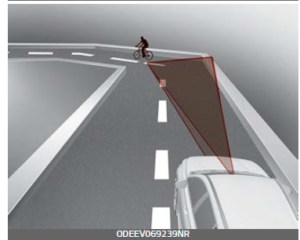
The front view camera or radar sensor recognition function may not detect the vehicle, pedestrian or cyclist traveling in front on a curved road.
Always pay attention to road and driving conditions, and if necessary, depress the brake pedal to reduce your driving speed in order to maintain a safe distance.

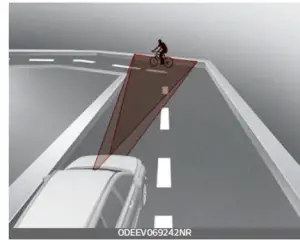
Forward Collision-Avoidance Assist may detect a vehicle or pedestrian in the next lane or outside the lane when driving on a curved road. If this occurs, the unnecessarily alarm the driver and apply the brake. Always check the traffic conditions around the vehicle.
- Driving on a sloped road.

Forward Collision-Avoidance Assist may not detect another vehicle, pedestrians or cyclists in front while driving uphill or downhill and this may result in no warning, or braking assist when necessary. When the function suddenly recognizes the vehicle, pedestrian or cyclist in front while passing over a slope, you may experience sharp deceleration.
Always keep your eyes forward while driving upward or downward on a slope, and, if necessary, depress the brake pedal to reduce your driving speed in order to maintain distance.
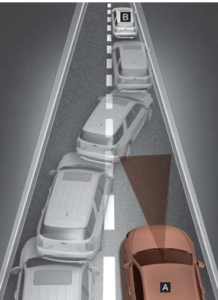
- Changing lanes
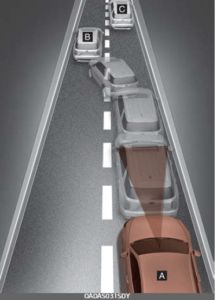
[A]: Your Vehicle
[B]: Lane changing vehicle
When a vehicle changes lanes in front of you, Forward Collision-Avoidance Assist may not immediately detect the vehicle, especially if the vehicle changes lanes abruptly. In this case, you must maintain a safe braking distance, and if necessary, depress the brake pedal to reduce your driving speed in order to maintain a safe distance.
- Recognizing the vehicle
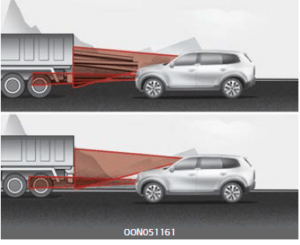
When the vehicle in front has heavy loading extended rearward, or when the vehicle in front has higher ground clearance, it may induce a hazardous situation. Always pay attention to road and driving conditions, while driving and, if necessary, depress the brake pedal to reduce your driving speed in order to maintain distance.
WARNING
- When you are towing a trailer or another vehicle, we recommend that Forward Collision-Avoidance Assist is turned off due to safety reasons.
- Forward Collision-Avoidance Assist may operate if objects that are similar in shape or characteristics to vehicles, pedestrians or cyclists are detected.
- Forward Collision-Avoidance Assist does not operate on bicycles, motorcycles, or smaller wheeled objects, such as luggage bags, shopping carts, or strollers that are dragged by a pedestrian or a cyclist.
- Forward Collision-Avoidance Assist may not operate normally if interfered by strong electromagnetic waves.
- Forward Collision-Avoidance Assist may not operate for 15 seconds after the vehicle is started, or the front view camera is initialized.
This device complies with Part 15 of the FCC rules.
Operation is subject to the following three conditions:
- This device may not cause harmful interference, and
- This device must accept any interference received, including interference that may cause undesired operation.
- Changes or modifications not expressly approved by the party responsible for compliance could void the user’s authority to operate the device.
Radiofrequency radiation exposure information:
This equipment complies with FCC radiation exposure limits set forth for an uncontrolled environment. This equipment should be installed
Lane Keeping Assist (LKA)
Lane Keeping Assist is designed to help detect the lane markers while driving over a certain speed. The function will warn the driver if the vehicle leaves the lane without using the turn signal, or will automatically assist the driver’s steering to help prevent the vehicle from departing the lane.
NOTICE
LKA stands for Lane Keeping Assist.
Detecting sensor

[1]: Front view camera
The front view camera is used as a detecting sensor to detect lane markings.
Refer to the picture above for the detailed location of the detecting sensor.
Lane Keeping Assist Settings Setting features
Lane Safety
With the ENGINE START/STOP button in the ON position, press the MODE button ( ) several times on the
steering wheel until User Settings menu appears on the LCD display. Select Driver Assistance → Lane Safety from the settings menu to set whether or not to use each function.
- If Lane Keeping Assist is selected, the function will automatically assist the driver’s steering when lane departure is detected to help prevent the vehicle from moving out of its lane. If Lane Departure Warning is selected, the function will warn the driver with an audible warning when lane departure is detected. The driver must steer the vehicle.
- If Off is selected, the function will turn off. The indicator light ( ) will turn off on the cluster.
WARNING
- If Lane Departure Warning is selected, steering is not assisted.
- Lane Keeping Assist does not control the steering wheel when the vehicle is driven in the middle of the lane.
- The driver should always be aware of the surroundings and steer the vehicle if Off is selected.
Turning Lane Keeping Assist On/Off
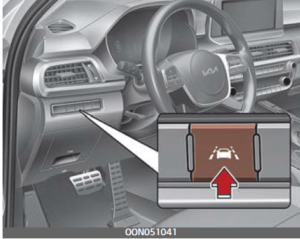
With the ENGINE START/STOP button in the ON position, press the Lane Safety button located on the instrument panel to turn on Lane Keeping Assist. The white indicator light ( ) will illuminate on the cluster. Press the button again to turn off the function.
NOTICE
- If the engine is restarted, Lane Keeping Assist will maintain the last setting.
- When Lane Keeping Assist is turned off with the Lane Safety button, Lane Safety system settings will turn off.
Warning Volume
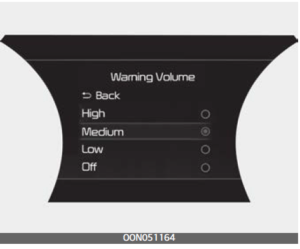
With the ENGINE START/STOP button in the ON position, press the MODE button ( ) several times on the steering wheel until User Settings menu appears on the LCD display. Select Driver Assistance → Warning Volume to change the warning volume to High, Medium, Low or
Off for Lane Keeping Assist.
If you change the Warning Volume, the Warning Volume of other Driver Assistance systems may be changed.
Lane-Keeping Assist Operation
Warning and Control
Lane Keeping Assist will warn and control the vehicle with Lane Departure Warning and Lane Keeping Assist.
2023 Kia Telluride Specs, Price, Features and Mileage (Brochure)
Lane Departure Warning
Left
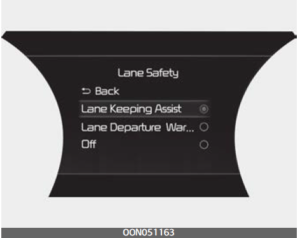
Right
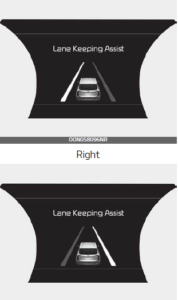
- To warn the driver that the vehicle is departing from the projected lane in front, the green ( ) indicator light will blink on the cluster, the lane line will blink on the cluster depending on which direction the vehicle is veering, and an audible warning will sound.
- The function will operate when your vehicle speed is between approximately 40~105 mph (64~169 km/h).
Lane Keeping Assist
- To warn the driver that the vehicle is departing from the projected lane in front, the green ( ) indicator light will blink on the cluster, and the steering wheel will make adjustments to keep the vehicle inside the lane.
- The function will operate when your vehicle speed is between approximately 40~105 mph (64~169 km/h).
Hands-off warning
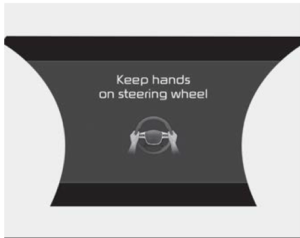
If the driver takes their hands off the steering wheel for several seconds, the Keep hands on steering wheel warning message will appear on the cluster, and an audible warning will sound in stages.
WARNING
- The steering wheel may not be assisted if the steering wheel is held very tight or the steering wheel is steered over a certain degree.
- Lane Keeping Assist does not operate at all times. It is the responsibility of the driver to safely steer the vehicle and to maintain the vehicle in its lane.
- The hands-off warning message may appear late depending on road conditions. Always have your hands on the steering wheel while driving.
- If the steering wheel is held very lightly, the hands-off warning message may appear because the function may not recognize that the driver has their hands on the steering wheel.
- If you attach objects to the steering wheel, the hands-off warning may not work properly.
NOTICE
When lane markings are detected, the lane lines on the cluster will change from gray to white and the green ( ) indicator light will illuminate if Lane Keeping Assist is operable.
Lane undetected
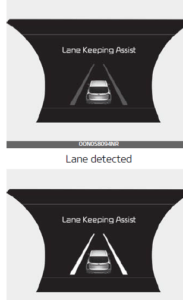
- Even though the steering is assisted by Lane Keeping Assist, the driver may control the steering wheel.
- The steering wheel may feel heavier or lighter when the steering wheel is assisted by Lane Keeping Assist than when it is not.
Lane Keeping Assist Malfunction and Limitations
Lane Keeping Assist malfunction 
When Lane Keeping Assist is not working properly, the Check Lane Keeping Assist (LKA) system, warning message will appear and the yellow ( ) indicator light will illuminate on the cluster. In this case, have the function checked by an authorized Kia dealer.
Limitations of Lane-Keeping Assist
Lane Keeping Assist may not operate normally or may operate unexpectedly under the following circumstances:
- The lane is contaminated or difficult to distinguish because,
- The lane markings is covered with rain, snow, dirt, oil, etc.
- The color of the lane marking is not distinguishable from the road
- There are markings on the road near the lane or the markings on the road look similar to the lane markings
- The lane marking is indistinct or damaged
- The shadow is on the lane marking by a median strip, trees, guardrail, noise barriers, etc.
- There are more than two-lane markings on the road
- The lane number increases or decreases, or the lane markings are crossing
- The lane markings are complicated or a structure substitutes for the lines, such as a construction area
- There are road markings, such as zigzag lanes, crosswalk markings and road signs
- The lane suddenly disappears, such as at the intersection
- The lane is very wide or narrow
- There is a road edge without a lane
- There is a boundary structure in the roadway, such as a tollgate, sidewalk, curb, etc.
- The distance to the front vehicle
WARNING
Take the following precautions when using Lane Keeping Assist: The driver should hold their possibility to safely drive and control the vehicle. Do not solely rely on the function and drive dangerously.
- The operation of Lane Keeping Assist can be cancelled or not work properly depending on road conditions and surroundings. Always be cautious while driving.
- When you are towing a trailer or another vehicle, we recommend that Lane Keeping Assist is turned off due to safety reasons.
- If the vehicle is driven at high speed, the steering wheel will not be controlled. The driver must always follow the speed limit when using the function.
- If any other function warning message is displayed or an audible warning is generated, the Lane Keeping Assist warning message may
FAQ
Forward Collision-Avoidance Assist is a safety feature that uses sensors and cameras to monitor the road ahead for potential collisions with vehicles or pedestrians.
If the system detects a potential collision, it can alert the driver and, if necessary, automatically apply the brakes to help avoid or mitigate the impact.
Typically, the driver can adjust the sensitivity of FCA or turn it on or off, allowing for customization based on their preferences.
Lane Keeping Assist is a driver assistance feature that helps the driver maintain proper lane alignment by gently steering the vehicle back into the lane if unintentional drifting occurs.
LKA uses sensors to monitor the vehicle’s position within the lane and provides steering input to keep it centered when it detects the vehicle is straying from the lane.
Yes, the driver can typically override LKA by applying sufficient steering force, allowing for manual control when needed.
Yes, the 2022 Kia Telluride often includes adaptive cruise control, which can adjust the vehicle’s speed to maintain a safe following distance from the vehicle ahead.
The availability of FCA and LKA may vary depending on the trim level and options chosen.
Yes, FCA and LKA can typically be used simultaneously to provide comprehensive safety and driver assistance.
The vehicle usually provides visual and audible alerts to inform the driver when FCA or LKA is engaged and actively assisting.
The effectiveness of these systems can vary, but they are typically designed for use at a wide range of speeds, including highway driving and lower-speed urban environments.
These systems are designed to operate without regular maintenance, but it’s important to follow manufacturer recommendations for calibration and servicing as needed.
While FCA and LKA can significantly reduce the risk of collisions and lane departures, they may not prevent all incidents, especially in extreme conditions or situations beyond their capabilities.
FCA and LKA provide an added layer of safety by helping drivers avoid or mitigate collisions and maintain proper lane discipline, reducing the risk of accidents caused by inattention or human error.
Yes, these systems may have limitations, such as reduced effectiveness in adverse weather conditions, poor lane markings, or situations where the sensors cannot adequately detect obstacles or road markings. It’s essential for drivers to remain attentive and use these systems as aids rather than substitutes for safe driving practices.
Useful Link
View Full User Guide: Kia Telluride 2022 User Guide
Download Manuals: https://owners.kia.com/content/owners/en/manuals.html
2023 Kia Telluride Specs, Price, Features and Mileage (Brochure)

